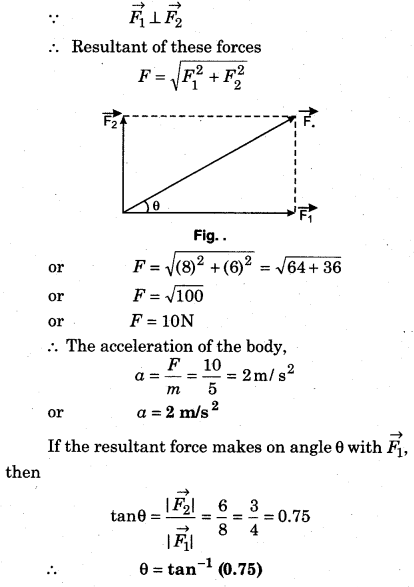Rajasthan Board RBSE Class 11 Physics Chapter 4 Laws of Motion
RBSE Class 11 Physics Chapter 4 Textbook Exercises with Solutions
RBSE Class 11 Physics Chapter 4 Very Short Answer Type Questions
Question 1.
If the net force on an object is zero, then, what will be its acceleration?
Answer:
Zero because F = ma ⇒ a = \(\frac{F}{m}\),
when, F = 0 ⇒ a = \(\frac{0}{m}\) = 0 .
Question 2.
Write the formula for momentum of a body.
Answer:
\(\vec{p}=m \vec{v}\) where m = mass of body and \(\vec{v}\) = velocity of the body.
Question 3.
Write the Newton’s second law of motion in terms of a formula.
Answer:
\( \vec{F}=\frac{d \vec{p}}{d t}=\frac{d}{d t}[m \vec{v}]=\frac{m d v}{d t}+\frac{v d m}{d t}\)
Question 4.
What are the directions of action and reaction in Newton’s third law of motion?
Answer:
Opposite to each other but act on different bodies.
Question 5.
Give an example of a system with variable mass.
Answer:
Rocket propulsion.
Question 6.
Of two contact surfaces, whose value is more : Static or kinetic friction?
Answer:
Static because fs > fk i. e., static friction is more than dynamic friction.
Question 7.
Whose value is more μs or μk?
Answer:
μs > μk because fs > fk.
Question 8.
Which force acts on a uniform circular motion?
Answer:
Centripetal.
Question 9.
How does a vehicle obtain a centripetal force on a levelled circular path?
Answer:
By frictional force.
Question 10.
How does a centripetal force other than frictional force is obtained on a banked circular path?
Answer:
By the horizontal component of the normal force i.e., by N sinθ.
RBSE Class 11 Physics Chapter 4 Short Answer Type Questions
Question 1.
Explain why passengers are thrown forward from their seats when a speeding bus stops suddenly?
Answer:
The lower part of the body of passengers (which is in contact with the bus) comes to rest, but because of inertia, the upper part of the body tends to keep on moving. As a result of it the rider falls forward.
Question 2.
Why is Newton’s first law of motion called law of inertia?
Answer:
According to Newton’s first law of motion, in absence of external force, there is no change in state of a body and inertia is the property of a body due to which it opposes the change in its state. That is the reason. Newton’s first law of motion is also known as the law of inertia.
Question 3.
Explain why a cricketer moves his hand backwards while holding a catch?
Answer:
The impulse received by the hand, while taking a catch is equal to the product of force applied and time taken to complete the catch. By moving his hand backward, the cricketer increases time interval so that he does is not hurt due to the applied lower impulsive force on the hand.
Question 4.
Define force.
Answer:
Force is a physical quantity which tries to change the state of body. It is a vector quantity. It’s S.I. unit is Newton (N).
Question 5.
When the acceleration of a particle is measured in an inertial system as zero. Can we say that no force acts on the particle? Explain.
Answer:
In inertial frame of reference, Newton’s first and second laws are valid. The motion is defined on relative basis. Generally, we define the motion assuming the earth to. be stationary and the Earth is supposed to be the inertial frame of reference. Therefore, the gravitational force acts on a body on the , Earth even when its acceleration is zero.
Question 6.
According to Newton’s third law of motion, in a game of tug, each team pulls the opposing team with equal force. Then, why a team wins and the other one loses?
Answer:
In the game of tug, till both the teams pull the rope with the same force, the net force on the system remains zero. As the force applied by one team increases than the other one, the whole system starts moving in the direction of net force. Thus one team wins and the other one loses.
Question 7.
A book is placed on a table. The weight of the book and the normal force by table on the book is equal in magnitude and direction. Can it be an example of Newton’s third law of motion? Explain.
Answer:
Yes; because according to the third law of motion, the magnitude of both the forces should be – equal and directions opposite and both forces should act on two different objects. Here both above conditions are fullfilled.
Question 8.
Define impulse acting on a body.
Answer:
Impulse is total effect of force on motion of a body. It’s value is equal to the product of applied force and time interval for which force is applied.
If a force is applied for a small time interval ‘dt then impulse of force. \(\vec{I}=\vec{F} \cdot d t\)
Question 9.
What is an impulsive force?
Answer:
Those forces of large magnitude which act for a very short time interval (e.g, time of contact), are known as impulsive force.
Question 10.
Write the impulse-momentum theorem?
Answer:
According to this theorem, impulse of a force is equal to change in momentum due to that force.
i.e., I = \(\Delta \vec{p}=\vec{p}_{2}-\vec{p}_{1}\)
Question 11.
Write the law of conservation of momentum.
Answer:
According to this law, net linear momentum of a system remains constant in absence of external force.
According to Newton’s second law of motion
F = \(\frac{d p}{d t}\)
If external force is zero i.e., F = 0
then \(\frac{d p}{d t}\) = 0
⇒ p = constant
Question 12.
What is an isolated system?
Answer:
Such a system which have no relation with external environment is called an isolated system.
Question 13.
Why a gun recoils backward when a bullet is fired?
Answer:
Bullet and gun form a system together. Before shooting the bullet by the gun, net momentum of this system is zero. The momentum of the gun is equal to the momentum of the bullet and is in opposite direction to conserve the momentum, when the gun is fired.
Question 14.
How many types of friction are there?
Answer:
There are two types of friction :
(i) Static friction : This type of friction acts till the body does not move, therefore this type of friction is known as static friction. The maximum static friction is known as “Limiting friction”.
(ii) Dynamic or kinetic friction : When the body starts moving,then the acting friction is known as dynamic or kinetic friction. Its value is some less than the limiting friction.
Question 15.
Define centripetal acceleration.
Answer:
When a particle moves on a circular path then an acceleration acts on the particle towards the centre of the circular path, this is known as centripetal acceleration.
Question 16.
Why is a road banked on a circular turn?
Answer:
Since circular motion of a particle is possible only when a centripetal force acts on it. Without centripetal force, the path cannot be circular. While passing through a circular turn of the road, its path becomes circular, therefore to obtain the required centripetal force, the vehicle bends towards the centre of the road. By this action, if the road is horizontal, then the outer wheels of the vehicle will not remain in contact with the road and it may overturn. To award this unhappening the road is banked towards the centre of the path.
Thus, on banked road, all the wheels of the vehicle remain in contact with the road and required centripetal force is obtained by a horizontal component of normal reaction of the road and the vehicle passes safely through the turn of the road.
Question 17.
Define inertial frame of reference.
Answer:
Inertial frame of reference : The frame of reference in which Newton’s first and second laws are valid is known as inertial frame of reference.
Question 18.
Define non-inertial frame of reference.
Answer:
The frame of reference in which Newton’s first and second laws are not valid, are known as non-inertial frame of reference. .
Question 19.
Is Earth an inertial frame of reference?
Answer:
Earth is revolving round the Sun. Therefore, it possesses centripetal acceleration. Therefore, it should be treated as non-inertial frame of reference. However, value of centripetal acceleration of the Earth,
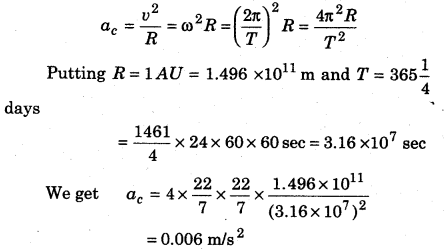
Which is negligible small compared to acceleration due to gravity (g= 9.8m/s2). Hence for terrestrial experiments, the Earth can be considered as an inertial frame.
RBSE Class 11 Physics Chapter 4 Long Answer Type Questions
Question 1.
What is Newton’s second law of motion? Define it. Obtain Newton’s first law from it.
Answer:
Momentum and Newton’s Second Law of Motion
Linear momentum : Momentum of body is the physical quantity of motion possessed by the body and mathematically, It is defined as the product of mass and velocity of the body.
As the linear momentum or simply momentum is equal to a scalar times a vector (velocity), it is therefore a vector quantity and is denoted by \(\vec{p}\). The momentum of a body of mass m moving with velocity \(\vec{v}\) is given by the relation :
\(\vec{p}=m \vec{v}\)
Dimensional formula = [M1L1T-1]
Unit = Kg m/s
Suppose that a ball of mass m1 and a car of mass m2 (m2 > m1) are moving with the same velocity v. If P1 and p2 are momentum of ball and car respectively then :
\(\frac{p_{1}}{p_{2}}=\frac{m_{1} v}{m_{2} v}\) or \(\frac{p_{1}}{p_{2}}=\frac{m_{1}}{m_{2}}\)
As m2 > m1: It follows that p2 > p1. If a ball and a car are travelling with the same velocity, the momentum of the car will be greater than that of the ball. Similarly, we can show that if two objects of same masses are thrown at different velocities, the one moving with the greater velocity possesses greater momentum. Finally, if two objects of masses m1 and m2 are moving with velocities v1 and v2 possesses equal momentum.
m1v1 = m2 v2
\(\frac{v_{1}}{v_{2}}=\frac{m_{2}}{m_{1}}\)
In case m2 > m1 then v2 < v1 i. e, two bodies of different masses possess same momentum, the lighter body possesses greater velocity.
The concept of momentum was introduced by Newton in order to measure the quantitative effect of force.
Momentum of body in term of kinetic energy
Ek = \(\frac{1}{2}\) mv2 ……….. (1)
but p = mv
∴ v = p/m
put in equation (1)
Ek = \(\frac{1}{2} m \frac{p^{2}}{m^{2}}=\frac{p^{2}}{2 m}\)
Question 2.
Explain Newton’s third law of motion with the help of two examples.
Answer:
Newton’s Third Law of Motion
If an object ‘A’ exerts force on object ‘B’, then object B must exert a force of equal magnitude and opposite direction back on object ‘A’.
This law represents a certain symmetry in nature : forces always occur in pairs, and one body cannot exert a force on another without experiencing a force itself. We sometimes refer to this law loosely as action-reaction, where the force exerted is the action and the force experienced as a consequence is the reaction.
According to Newton’s third law, “To every action, there is always an equal and opposite reaction”.
It must be remembered that action and reaction always act on different objects. The third law of motion indicates that when one object exerts a force on another object, the second object instantaneously exerts a force back on the object. These two forces are always equal in magnitude, but opposite in direction.
These forces act on different objects and so they do not cancel each other. Thus Newton’s third law of motion describes the relationship between the forces of interaction between two objects.
For example, when we placed a wooden block on the ground, this block exerts a force equal to its weight, W = mg acting downwards to the ground. This is the action force. The ground exerts an equal and opposite force N = mg on the block in upward direction. This is the reaction force.
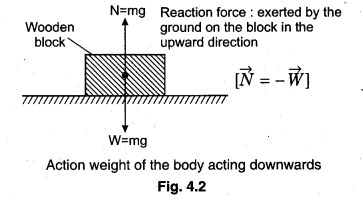
Illustrations of Newton’s Third Law
Some of the examples of Newton’s third law of motion are given below :
1. A gun recoils when a bullet is fired form it: When a bullet is fired from a gun, the gun exerts a force on the bullet in the forward direction. This is the action force. The bullet also exerts an equal force on the gun in the backward direction. This is the reaction force. Due to the large mass of the gun it moves only a
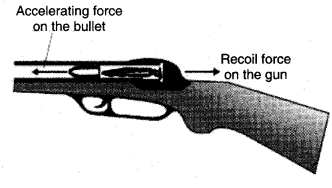
little backward by giving a jerk at the shoulder of the gun man. The backward movement of the gun is called the recoil of the gun.
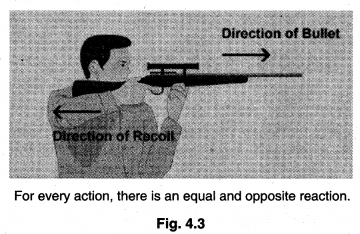
2. Walking: In order to walk, we press the ground in backward direction with our feet (action). In turns, the ground gives an equal and opposite reaction R, (figure 4.4 (a). The reaction R can be resolved into two components, one along the horizontal and other along the vertical. The component H = R cosθ along the horizontal, help us to move forward, while the vertical component, V = R sinθ opposes our weight, [figure 4.4 (b)]
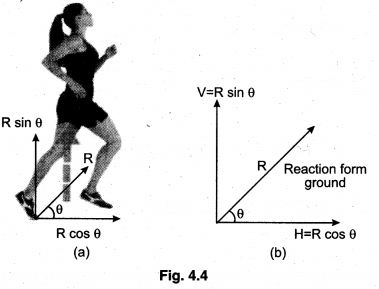
Question 3.
Write impulse-momentum theorem and prove it. How will you find out the impulse from a graph?
Answer:
Impulse-Momentum Theorem .
A force which acts on a body for short interval of time is called impulsive force or impulse.
For Example : Hitting, jumping, diving, catching etc. are all examples of impulsive forces or impulse.
An impulsive force does not remain constant, but changes first from zero to maximum and then from maximum to zero. Thus it is not possible to measure easily the value of impulsive force because it changes with time. In such cases, we measure the total effect of the force, called impulse hence, impulse is defined as the product of the average force and the time interval for which the force acts. If \(\vec{F}\) is the value of force during impact at any time and \(\vec{p}\) is the momentum of the body at that time, then according to Newton’s second law of motion,
\(\vec{F}=\frac{d \vec{p}}{d t}\)
or \(\vec{F} d t=d \vec{p}\)
Suppose that the impact lasts for a small time t and during this time, the momentum of the body changes from \(\vec{p}_{1}\) to \(\vec{p}_{2}\) then integrating the above equation between the proper limits, we have :
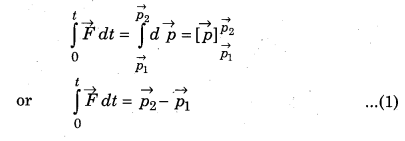
It may be noted that \(\vec{F}\) has not been taken out of the integration sign for the reason that \(\vec{F}\) varies with time and does not remain constant during impact. The integral \(\int_{0}^{t} \vec{F}\) dt is measure of the impulse, when the force of impact acts on the body and from equation (1) we find that it is equal to total change in momentum of the body. Since impulse is equal to a scalar (time) times a vector (force) or equal to the change in momentum (vector), it is a vector quantity and it is denoted by \(\vec{I}\).
Therefore, \(\vec{I}=\int_{0}^{t} \vec{F} d t=\vec{p}_{2}-\vec{p}_{1}\)
However if \(\vec{F}_{a v}\) is the average force (constant) during the impact, then

i. e., the change in momentum of an object equals to the impulse applied to it. This statement is called
impulse-momentum theorem.
I = Δp
Dimensional Formula and Unit :
I = FΔt = [M1L1T-2] [T1]= [M1L1T-1]
So, the dimensional formula of impulse is same as that of momentum.
The SI unit of impulse are (N-s) and kg m/s.
In C.G.S. system unit of impulse are dyne-sec and g cm/s.
Force Time Curve : In the real world, forces are often not constant. Forces may build up from zero over time and also may vary depending on many factors.
Finding out the overall effect of all these forces directly would be quite difficult. As we calculate impulse, we multiply force by time. This is equivalent to finding out the area under a force time curve. For variable force the shape of the force-time curve would be complicated but for a constant force we will get a simpler rectangle. In any case, the overall net impulse only matters to understand the motion of an object following an impulse.
In the figure, the graph of change in impulsive force with the time is shown :
The force-time curve and the area between the time axis can be divided in the form of many slabs. Suppose the value of force F is considered as constant along the change in time dt, then area of slab is given by F. dt.
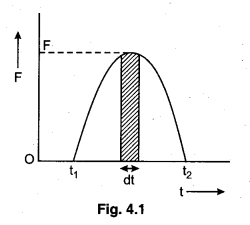
Total effect of the force for time t1 to t2
= \(\int_{0}^{t} \vec{F}\) dt = sum of area of all slabs
= graph of force-time and area covered between the time axis
∵ By the impulse – momentum theorem t
Impulse I = \(\int_{0}^{t} F d t\) = p2 – p1 = change in momentum. Thus force-time graph and the area covered with the time axis is equal to the total change in the momentum of the body.
Question 4.
Write the law of conservation of momentum for a,system of N particles. Obtain it from Newton’s second law of motion. Explain the law of conservation of momentum with the help of an example.
Answer:
Principle of Conservation of Linear Momentum and its Applications
If the net external force acting on a system of bodies is zero, then the momentum of the system remains constant. This is the basic principle of conservation of linear momentum.
According to Newton’s second law
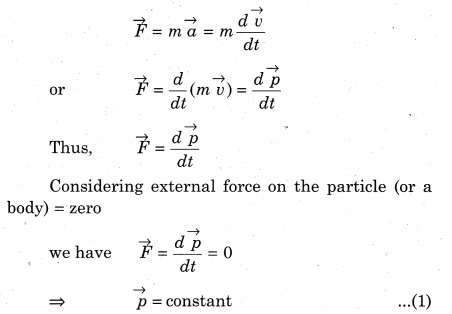
If net force (or the vector sum of all forces) on system of particle is equal to zero, the vector sum of linear momentum of all particles remains conserved.
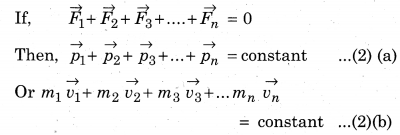
Consider a system of two bodies on which no external force acts. The bodies can mutually interact with each other. Due to the mutual interaction of the bodies the momentum of the individual bodies may increase or decrease according to the situation, but the momentum of the system will always be conserved, as long as there is no external net force acting on it.
Thus, if \(\vec{p}_{1}\) and \(\vec{p}_{2}\) are momentum of the two bodies at any instant, then in absence of external force
\(\vec{p}_{1}+\vec{p}_{2}\) = constant ……………. (3)
If due to mutual interaction, the momentum of two bodies becomes \(\overrightarrow{p_{1}^{\prime}}\) and \(\overrightarrow{p_{2}^{\prime}}\) respectively, then according to principle of conservation of momentum
\(\overrightarrow{p_{1}}+\overrightarrow{p_{2}}=\overrightarrow{p_{1}^{\prime}}+\overrightarrow{p_{2}^{\prime}}\)
or \(m_{1} \overrightarrow{u_{1}}+m_{2} \overrightarrow{u_{2}}=m_{1} \overrightarrow{v_{1}}+m_{2} \overrightarrow{v_{2}}\) ……………. (4)
Where \(\overrightarrow{u_{1}}\) and \(\overrightarrow{u_{2}}\) are initial velocities of the two bodies of masses m1 and m2 and \(\overrightarrow{v_{1}}\) and \(\overrightarrow{v_{2}}\) are their final velocities.
Therefore, the principle of conservation of linear momentum may also be stated as follows :
For an isolated system (a system on which no external force acts), the initial momentum of the systerA is equal to the final momentum of the system.
Practical Applications of the Principle of Conservation of Momentum
1. Recoiling a Gun : Lets consider the gun and bullet in its barrel as an isolated system. In the beginning when bullet is not fired both the gun and the bullet are at rest. So the momentum before firing is zero
or \(\overrightarrow{p_{c}}\) = 0
Now when the bullet is fired, it moves , in the forward direction and gun recoils back in the opposite direction.
Let mb be the mass and vb be the velocity of the bullet and mg and vg be the mass and velocity of the gun after firing.
Total momentum of the system after the firing would be
\(\overrightarrow{p_{f}}=m_{b} \overrightarrow{v_{b}}+m_{g} \overrightarrow{v_{g}}\)
Since, no external forces are acting on the system, we can apply the law of conservation of linear momentum therefore,
Total momentum of gun and bullet before firing
= Total momentum of gun and bullet after firing
\(0=m_{b} \overrightarrow{v_{b}}+m_{g} \vec{v}_{g}\)
or \(\overrightarrow{v_{g}}=-\frac{m_{b} \vec{v}_{b}}{m_{g}}\)
The negative sign shows that \(\vec{v}_{g}\) and \(\vec{v}_{b}\) are in opposite directions i.e., as the bullet moves forward, then the gun will move in backward direction. The backward motion of the gun is called recoil of the gun.
2. While firing a bullet, the gun must be held tight to the shoulder : This would save hurting the shoulder of the man who fires the gun as the recoil velocity of the gun. If the gun is held tight to the shoulder, then the gun and the body of the man recoil as one system. As the total mass is quite large, the recoil velocity will be very small and the shoulder of the man will not get hurt.
3. Rockets works on the principle of conservation of momentum : The rocket’s fuel burns and pushes the exhaust gases downwards, due to this the rocket gets pushed upwards. Motorboats also work on the same principle, it pushes the water backwards and gets pushed forward in reaction to conserve momentum.
Second Law of Motion is the real law of Motion :
(A) First law is contained in the second law :
According to Newton’s second law of motion, the force acting on a body is given by :
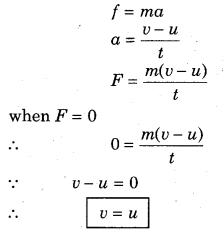
Thus there is no force is applied on the body then the body at rest will remains at rest and a body in uniform motion will continue to move uniformly along the same straight path. Hence first law of motion is contained in the second law.
Question 5.
Explain the motion of a rocket and obtain the important formula for its velocity?
Answer:
Motion of a Rocket: As the fuel in the rocket is burnt and the exhaust gas is expelled out from the rear of the rocket in the downward direction. The force exerted by the exhaust gas on the rocket is equal and opposite to the force exerted by the rocket to expel it. This force exerted by the exhaust gas on the rocket provides an upthrust to the rocket. The more gas is ejected from the rocket, the mass of the rocket decreases.
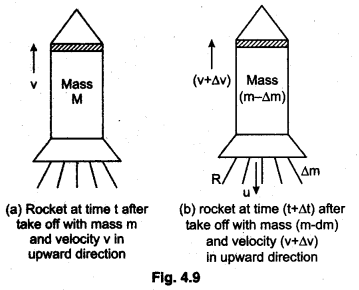
To analyze this process let us consider a rocket being fired in upward direction and we neglect the resistance offered by the air to the motion of the rocket and variation in the value of the acceleration due to the gravity with height.
Figure 4.9. (a) shows a rocket of mass ‘m’ at a time ‘t’ after its take off moving with velocity v. Thus at time ‘t’ momentum of the rocket is equal to ‘Mv’
Thus \(\vec{p}_{c}=M \vec{v}\) ………………(1)
Now after a short interval of time dt, gas of total mass dm is ejected from the rocket. If vg represents the downwards speed of the gas relative to the rocket then velocity of the gas relative to the earth is
\(\overrightarrow{v_{g e}}=\vec{v}-\overrightarrow{v_{g}}\)
At time (t + dt), the rocket and unburned fuel gases mass (M – dm) and it moves with the speed of (\(\overrightarrow{V}+d \vec{V}\)). Thus, momentum of the rocket is :
=(M – dm)(\(\vec{v}+d \vec{v}\))
Total momentum of the system at time (t + dt) is
\(\vec{p}_{f}=d m\left(\vec{v}-\vec{v}_{g}\right)+(M-d m)(\vec{v}+d \vec{v})\) ………………. (2)
Here, the ejected gas and rocket constitutes a system at time (t + dt).
External force on the rocket is weight (-mg) of the rocket (the upward direction is taken as positive)
Now Impulse = Change is momentum
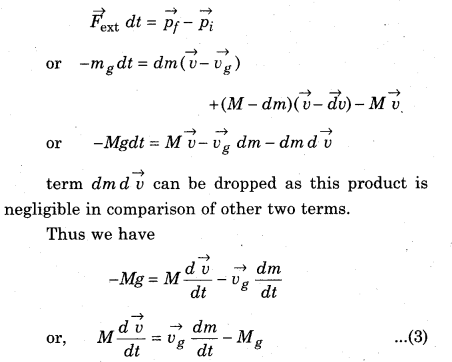
In equation (iii) \(\frac{d \vec{V}}{d t}\) represent the acceleration of dt the rocket, so M\(\frac{d v}{d t}\) = resultant force on the rocket. dt
Therefore,
Resultant force on rocket = Upthrust on the rocket – Weight of the rocket
Here the upthrust on the rocket is proportional to both the relative velocity (\(\vec{v}_{g}\)) of the ejected gas and the mass of the gas ejected per unit time \(\left(\frac{d m}{d t}\right)\)
Again from eq. (3)
\(\frac{d \vec{v}}{d t}=\frac{\vec{v}_{g}}{m} \frac{d m}{d t}-g\) ………………. (4)
As the rocket goes higher and higher, value of the acceleration due to gravity ‘g’ decreases continuously. The values of (vg) and {dm! dt). Practically remains constant while fuel is being consumed but remaining mass decreases continuously. This result increases in acceleration continues until all the fuel is burnt up.
Velocity of the rocket at any time ‘t’
Now we will find out the relation between the velocity at any time ‘t’ and remaining mass. Again from equation (4) we have
\(d \vec{v}=\vec{v}_{g}\left(\frac{d m}{M}\right)-g d t\) ………………. (5)
Initially at time t = 0 if the mass and velocity of the rocket are m0 and u0 respectively. After time ‘t’ if m and v are the mass and velocity of the rocket. On integrating equation (5) within these limits
\(\int_{v_{0}}^{v} d v=-\int_{M_{0}}^{M} v_{g} \frac{d m}{m}-\int_{0}^{t} g d t\) ……………….. (6)
Note : Here dm is a quantity of mass ejected in time ‘dt’ so change in mass of the rocket in time dt is -dm that’s why we have changed the sign of dm in equation (6).
On evaluating this integral we get
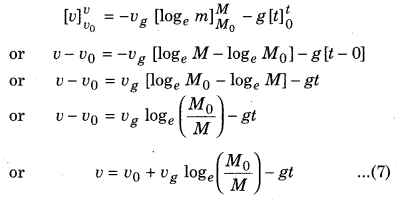
Equation (7) gives the change in velocity of the rocket in terms of exhaust speed and ratio of initial and final masses at any time ‘t’.
At time t = 0 the velocity of the rocket (initial velocity)

Note : The speed acquired by the rocket when the whole of the fuel is burnt out is called burn-out speed of the rocket.
Question 6.
How many types of friction are there? Write their laws.
Answer:
Explanation of Newton’s Second Law
According to Newton’s second law of motion, the rate of change of linear momentum of a body is directly proportional to the applied external force on the body, and this change takes place always in the direction of the applied force.
Let, m = mass of a body
v = velocity of the body
The linear momentum of the body
\(\vec{p}=m \vec{v}\) ………… (1)
let \(\vec{F}\) = External force applied on the body in the direction of motion of the body. .
\(\Delta \vec{p}\) = a small change in linear momentum of the body in a small time Δt.
Rate of change of linear momentum of the body = \(\frac{\Delta \vec{p}}{\Delta t}\)
According to Newton’s second law

Where k is proportionality constant. Taking the limit Δt → 0, the term \(\frac{\Delta \vec{p}}{\Delta t}\) becomes the
derivative or differential coefficient of \(\vec{p}\) w.r.t. time t.
It is denoted by \(\frac{d \vec{p}}{d t}\)
\(\vec{F}=k \frac{d \vec{p}}{d t}\)
Where k = 1 in all the system
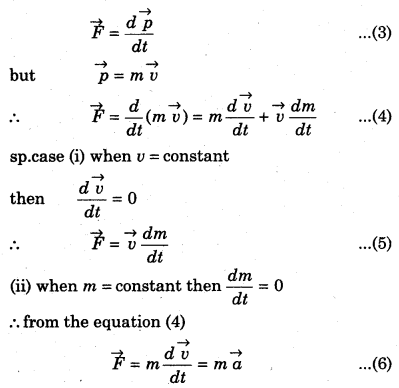
As accelerationtion is a vector quantity and mass is scalar, therefore force \(\vec{F}\) being the product of m and \(\vec{a}\) is a vector. The direction of \(\vec{F}\) is the same as the direction of \(\vec{a}\). Equation (4) represents the equation of motion of the body. We can rewrite equation (6) in scalar form as :
F = ma …………. (7)
Thus, magnitude of force can be calculated by multiplying mass of the body and the acceleration produced in it. Hence, second law of motion gives a measure of force.
Dimension and Unit of Force :
As F = ma
∴ F= [M1] [L1T-2 ] = [M1L1T-2 ]
This is the dimensional formula of force.
Unit of force
The unit of force is Newton in (M.K.S.) system and dyne in C.G.S. system and Poundal in (F.P.S.) system.
Definition of 1 Newton
F = ma
When m = 1kg and a = 1 m/s-2
then F = 1 Newton
The force which produces the acceleration of 1m/s-2 in the 1 kg body, is equal to the 1 Newton.
1 Newton = 1 kg m/ s2
In C.G.S. System F = ma
If m = 1 g and a = 1 cm/s2
then F = 1 dyne
Thus 1 dyne is that force which produces 1 cm/s2 acceleration in the mass of 1g body.
Question 7.
Explain how will you find out the direction of static friction?
Answer:
Static Frictional Force : Static friction is the friction that exists between a stationary object and the surface on which it resting. Static friction keeps an object at rest. It must is overcome to start moving the object.
Imagine trying to push an object across the floor. You push on it with a small force, but it does not move, this is because it is not accelerating. However, according to Newton’s second law, the object must move with an acceleration.
a = \(\frac{F}{m}\)
Now, as the body remains at rest, it implies that an opposing force equal to the applied force must have come into play resulting in zero net force on the object. This force is called static friction. It is denoted by Fs.
Thus, static friction is the opposing force that comes into play when one body tends to move over the surface of another, but the actual motion has not started.
- The static friction depends upon the nature of surfaces of the two bodies in contact.
- The static friction does not exist by itself. When there is no applied force, there is no static friction. It comes into play only when the applied force tends to move the body.
- The static friction is a self-adjusting force.
Limiting Friction : If the applied force is increased, the force of static friction also increases. If the applied force exceeds a certain (maximum) value, the body starts moving. This maximum value of static friction up to which the body does not move, is called limiting friction.
1. The magnitude of limiting- friction between any two bodies in contact is directly proportional to the normal reaction between them.
(fs)max ∝ N
(fs) max ∝ μs N ………….. (1)
Where the constant of proportionality p s is called the coefficient of static friction. Its value depends upon the nature of surfaces of the two bodies in contact that means whether dry or wet; rough or smooth; polished or non polished. For example, when two polished metal surfaces are in contact, ps = 0.2, when these surface are lubricated, μs = 0.1
The value of μs lies between 0 and 1 or 0 < μs < 1
∵ N = Mg
(Fs)max = μs mg ……………… (2)
2. Direction of the force of limiting friction is always opposite to the direction in which one body is at the verge of moving over the other.
3. Coefficient of Static Friction :
μs is called coefficient of static friction and is defined as the ratio of force of limiting friction and normal reaction
From(1), μs = \(\frac{\left(f_{s}\right)_{\max }}{N}\)
Dimension: [M0L0T0]
Unit: It has no unit.
Value of μs does not depend upon apparent area of contact.
Question 8.
Define the coefficients of static and kinetic friction. How will you find out their value?
Answer:
1. Static Frictional Force : Static friction is the friction that exists between a stationary object and the surface on which it resting. Static friction keeps an object at rest. It must is overcome to start moving the object.
Imagine trying to push an object across the floor. You push on it with a small force, but it does not move, this is because it is not accelerating. However, according to Newton’s second law, the object must move with an acceleration.
a = \(\frac{F}{m}\)
Now, as the body remains at rest, it implies that an opposing force equal to the applied force must have come into play resulting in zero net force on the object. This force is called static friction. It is denoted by Fs.
Thus, static friction is the opposing force that comes into play when one body tends to move over the surface of another, but the actual motion has not started.
- The static friction depends upon the nature of surfaces of the two bodies in contact.
- The static friction does not exist by itself. When there is no applied force, there is no static friction. It comes into play only when the applied force tends to move the body.
- he static friction is a self-adjusting force.
Limiting Friction : If the applied force is increased, the force of static friction also increases. If the applied force exceeds a certain (maximum) value, the body starts moving. This maximum value of static friction up to which the body does not move, is called limiting friction.
1. The magnitude of limiting- friction between any two bodies in contact is directly proportional to the normal reaction between them.
(fs)max ∝ N
(fs) max ∝ μs N ………….. (1)
Where the constant of proportionality p s is called the coefficient of static friction. Its value depends upon the nature of surfaces of the two bodies in contact that means whether dry or wet; rough or smooth; polished or non polished. For example, when two polished metal surfaces are in contact, ps = 0.2, when these surface are lubricated, μs = 0.1
The value of μs lies between 0 and 1 or 0 < μs < 1
∵ N = Mg
(Fs)max = μs mg ……………… (2)
2. Direction of the force of limiting friction is always opposite to the direction in which one body is at the verge of moving over the other.
3. Coefficient of Static Friction :
μs is called coefficient of static friction and is defined as the ratio of force of limiting friction and normal reaction
From(1), μs = \(\frac{\left(f_{s}\right)_{\max }}{N}\)
Dimension: [M0L0T0]
Unit: It has no unit.
Value of μs does not depend upon apparent area of contact.
2. Kinetic Friction : We know that when the applied force on a body is small, it may not move but as the applied force becomes greater than the force of limiting friction, the body is set into motion. The force of friction acting between the two surfaces in contact which are moving relatively, so as to oppose their motion, is known as kinetic frictional force.
1. Kinetic friction is directly proportional to the normal reaction i. e.,
fk ∝ N
or fk ∝ μkN ………….. (1)
Where μk, is called the coefficient of kinetic friction.
∵ N – mg
∴ fk = μkmg …………… (2)
2. Value of μk depends upon the nature of surface in contact.
3. Kinetic friction is always lesser than the limiting friction
fk < (fs)max
∴ μk < μs
i. e., Coefficient of kinetic friction is always less than coefficient of static friction. Thus we require more force to start a motion than to maintain it against friction. This is because once the motion starts actually; inertia of rest has been overcomed. Also when motion has actually started, irregularities of one surface have little time to get locked again into the irregularities of the other surface.
4. Kinetic friction does not depend upon the velocity of the body.
Question 9.
Explain the circular motion of an object in horizontal plane and determine the formula for its time period.
Answer:
Motion in a Horizontal Plane
Figure 4.19 shows a mass m tied to an end of a string of length L. The mass m moves in a horizontal plane with a constant speed. As the mass moves in the circle, the string sweeps a cone of an angle θ with the surface where θ is the angle made by the string with the normal. The forces that act on the mass m at any instant are shown in figure 4.19. If T is the tension in the string, then the components of T will be T cosθ and T sinθ. There is no vertical acceleration on m. So, the component T cos θ balances the weight W of m. This way
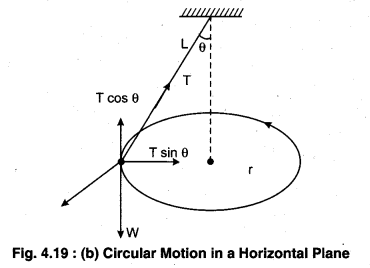
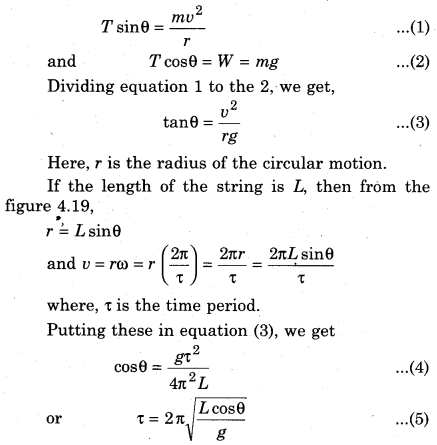
Here, the value of θ cannot be 90°, because then x will be zero or v = ∞.
The maximum value of τ will be
τmax = \(2 \pi \sqrt{\frac{L}{g}}\)
It is possible for very small angle (θ ≈ 0°) so that cosθ = cos 0° = 1.
Equation (5) represents the formula for the time period of a simple pendulum (we will study in chapter 8). With this similarty, the above device is called conical pendulum.
Question 10.
Explain the circular motion of an object in vertical plane. Find out the formula for the tension produced at the highest and lowest points in the string.
Answer:
Motion in a Vertical Plane Consider a body of mass m tied at the end of a string and whirled in a vertical circle of radius r. Let iq & v2 be velocities of the body and T1and T2 be tensions in the string at the lowest point A and the highest point B respectively. The velocities of the body at points A and B will be directed along tangents to the circular path at these points while tensions in the string will always act towards the fixed point O as shown in figure 4.20. At the lowest point A, a part of tension T, balances the weight of the body and the remaining part provides the necessary centripetal force. Therefore.
T1 – mg = \(\frac{m v_{1}^{2}}{r}\) ……….. (1)
At the highest point, the tension in the string and the weight of the body together provide the necessary centripetal force.
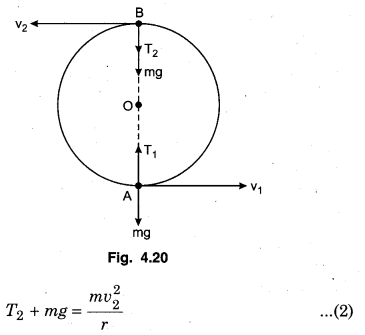
Let us now find the out minimum velocity, the body should possess at the lowest point, so that the string does not slack when it is at the highest point. The body is then said to just loop the vertical circle. It is obvious that the velocity at the lowest point will be minimum. When the velocity at the highest point is also minimum.
Minimum velocity at the highest point :
From equation (2), it follows that the velocity at the highest point will be minimum when the tension in the string at the highest point is zero.
T2 = 0 . ………… (3)
In that case, the whole of the centripetal force will be provided by the weight of body. Therefore in such a case, the equation (2) becomes :
0 + mg = \(\frac{m v_{2}^{2}}{r}\)
or v2 = \(\sqrt{g r}\) …………… (4)
This is the mininum velocity the body should possess at the top, so that it can just loop the vertical circle without the slackening of the string. In case the velocity of the body at point B is less than \(\sqrt{g r}\). The string will slack and the body will not loop the circle. Therefore, a body will just loop the vertical circle if it possesses velocity equal to \(\sqrt{g r}\) at the top.
Minimum velocity at the lowest point : According to the principle of conservation of energy.
K.E. of the body at point A = (P.E. + K.E) of the body at point B
\(\frac{1}{2} m v_{1}^{2}=m g(2 r)+\frac{1}{2} m v_{2}^{2}\)
or \(v_{1}^{2}=4 g r+v_{2}^{2}\)
As said earlier, when the velocity at the highest point is minimum. The velocity at the lowest point will also be minimum.
Setting v2 = \(\sqrt{g r}\), we have
\(v_{1}^{2}\) = 4gr + gr
or v1 = \(\sqrt{5 g r}\) ……….. (5)
’The equation (5) gives the magnitude of the velocity at the lowest point with which body can safely go round the vertical circle of radius r or can loop the circle of radius r. Let us find out the tension in the string at the lowest point in such a case.
In equation (1),
setting v1 = \(\sqrt{5 g r}\), we have
T1 – mg = \(\frac{m \times(\sqrt{5 g r})^{2}}{r}\)
or T1 – mg = 5mg
or T1 = 6mg
Question 11.
Explain the motion of a vehicle on a circular path and give the formula for maximum velocity.
Answer:
Motion of Vehicle on a Plane on a Circular Path
A circular turn on a level road : Consider a car of weight ‘mg’ going around on a circular turn of radius ‘r’ with velocity nona level road as shown in the figure 4.21. While rounding the curve, the wheels of the vehicle have a tedency to leave the curved path and regain the straight line path.
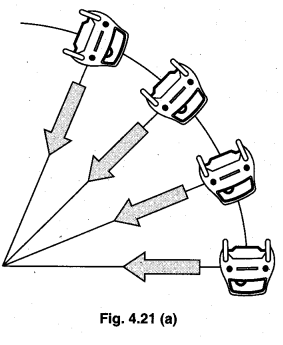
Force of friction between the wheel and the road opposes this tendency of the wheel. Therefore, this frictional force acts towards the centre of the circular path and provides the necessary centripetal force.
Three forces are acting on the car Figure 4.21.
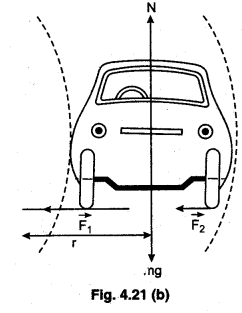
(i) The weight of the car, mg, acting vertically downwards,
(ii) Normal reaction N of the road on the car, acting vertically upwards,
(iii) Frictional force F, along the surface of the road, towards the centre of the turn,
As there is no acceleration in the vertical direction,
N – mg = 0
or N = mg ……….. (i)
Since, for safe driving of a car, on the circular path, the centripetal force must be equal to or less than friction force.
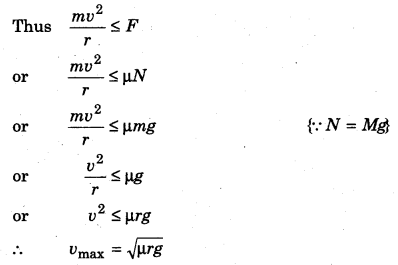
Here, μ is coefficient of static friction between the tyres and the road.
Hence, the maximum velocity with which a vehicle can go round a level curve; without slidding is
v = \(\sqrt{\mu r g}\)
The value of v depends upon :
(i) Radius r of the curve.
(ii) Coefficient of friction (μ) between the tyre and the road.
Clearly v is independent of the mass of the car
Question 12.
Why is a road banked on a circular turn? Obtain the maximum velocity of a vehicle on such a turn. If we assume that the friction on road is negligible, then obtain the banking angle.
Answer:
Banking of roads : The value of maximum velocity for a vehicle to take a circular turn (without skidding) on a level road is quite low. This limiting value of the velocity decreases further due to decrease in the value of the coefficient of friction p on a slippery road and for a vehicle, whose tyres have worn out. Therefore especially in hilly areas, where the vehicle has to move constantly along the curved tracks, the maximum speed at which it can be run, will be very low. If any attempt is made to run it at greater speed, the vehicle is likely to skid and go off the track. In order that the vehicle can go round the curved tracks at reasonable speed without skidding, the sufficient centripetal force is managed for it by raising the outer edge of the track a little above the inner one. It is called the banking of the circular tracks.
Consider a vehicle of weight ‘mg’ moving round a curved path of radius r with speed v on a road banked through angle θ. If OA is banked road and OX is a horizontal line, then ∠AOX = θ is called angle of banking, (figure 4.22).
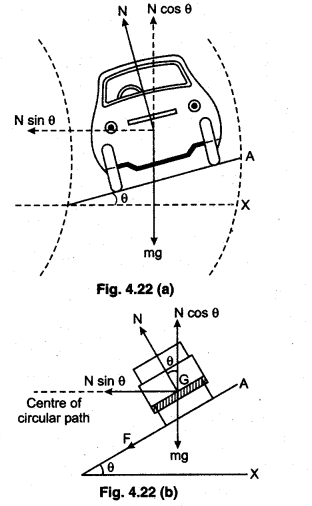
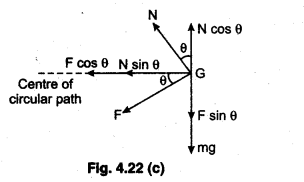
The vehicle is under the action of following forces :
(i) Weight ‘mg’ of the vehicle acting vertically downwards.
(ii) Normal reaction W of the ground to the vehicle acting along normal to the banked road OA in the upward direction.
(iii) Force of friction F’ between the banked road and the tyres, acting along OA
‘N’ can be resolved into two rectangular components :
(a) N cosθ, along vertically upward direction.
(b) N sinθ, along the horizontal, towards the centra of the curved round.
F’ can also be resolved into two rectangular components :
(a) Fsinθ, along vertically downward direction
(b) Fcosθ, along the horizontal, towards the centre of curved road.
As there is no acceleration along the vertical direction, the net force along this direction must be zero.
Therefore, N cosθ = mg + Fsinθ ………… (1)
The horizontal component N sinθ and Fcosθ will provide the necessary centripetal force to the vehicle,
Thus N sinθ + F cosθ = \(\frac{m v^{2}}{r}\) …………….. (2)
But F ≤ μsN, where μs is coefficient of static friction between the banked road and tyres. To obtain vmax, we Put F = μsN in equation (1) and (2)
∴ Ncosθ = mg + μsNsinθ …………. (3)
N sinθ + μsN cosθ = \(\frac{m v^{2}}{r}\) ……………….. (4)
From equation (3)
N (cosθ – μs sinθ) = mg
⇒ N = \(\frac{m g}{\left(\cos \theta-\mu_{s} \sin \theta\right)}\) …………… (5)
From equation (4) N (sinθ – μs cosθ) = \(\frac{m v^{2}}{r}\)
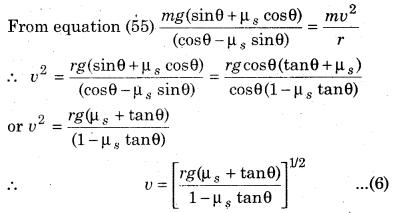
Equation (6) represents the maximum velocity of vehicle on a banked road.
Discussion :
(i) If μs = 0 i. e., if banked road is perfectly smooth, then from equation (6)
vmax = (rgtanθ)1/2 ………… (7)
This is the speed at which a banked road can be rounded even when there is no friction. Driving at this speed on banked road will cause no wear and tear of the tyres.
From equation (7) \(v_{\max }^{2}\) = rgtanθ
or tan = \(\frac{v_{\max }^{2}}{r g}\) …………….. (8)
(ii) If h is the height AB of outer edge of the road above the inner edge and l = OA is breadth of the road then from the figure 4.23.
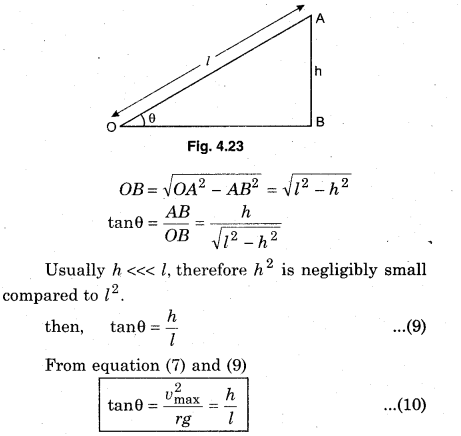
Roads are usually banked for the average speed of vehicles passing over them. However, if the speed of a vehicle is some what less or more than this, the self adjusting static friction will operate between the tyres and the road, and the vehicle will not skid.
On the same basis, curved railway tracks are also banked. The level of outer rail is raised a little above the level of inner rail, while lying a curved railway track.
Question 13.
Explain the motion of a body on an inclined plane.
Answer:
Motion on an Inclined Plane
Consider an inclined plane as shown in the figure (4.24) that makes an angle 0 with the horizontal plane OA Assume an object of mass m moving on this plane. Initially, let us suppose that the object does not move due to friction. Various forces act on the object.
(i) Weight of the object, W = mg
(ii) Normal reaction, N
(iii) Frictional force, fs
In the vertical direction, there is no acceleration. Balancing the components of weight, W = mg,
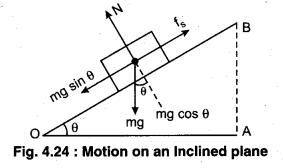
mg sinθ = fs …………. (1)
and, mg cosθ = N …………. (2)
Now, if we move the plane OB upwards so that 0 increases, then at a position, the object will start moving on the inclined plane OR At this postion
(fs)max = μsN
Where, μs is the coefficient of static friction between the object and the plane. In this position, let θ = θs (maximum value of the angle) and (fs)max are placed in the above expressions,
mg sinθs = μsN
mg cosθs = N
From above equations,
tanθs = μs ……….. (3)
From equation (3), we can determine the coefficient of static friction between the inclined plane and the surface of the object.
When the value of θ is slightly more than θs, then a small net force acts on the object and object starts to slide. We further increase the value of θ so that the object moves downward with accelerated motion.
Then, we keep on decreasing the value of θ so that the object moves with a constant velocity at θ = θk,. At this position, kinetic frictional force acts on the object.
Substituting fk in place of fs, μk in place of μs and θk in place of θs in equation (1 & 2), we get the following equations :
mg sinθk = fk ………….. (4)
mg cosθk = N ………….. (5)
Again, putting fk = μkN in above expressions,
tanθk = μk ……………. (6)
From equation (6), we can determine the coefficient of kinetic friction between the inclined plane and the surface of the object.
Knowing the distances of the horizontal plane OA and inclined plane OR we can find tanθs and tanθk using the relation, tanθ = \(\frac{A B}{O A}=\frac{\sqrt{O B^{2}-O A^{2}}}{O A}\) this way, we can find out the coefficient of friction.
Note that BA is perpendicular to OA.
Question 14.
Distinguish between the inertial and non-inertial frames of reference. Is Earth an inertial frame of reference? Explain.
Answer:
Inertial and Non-inertial Frames of Reference ;
Frame of Reference
Motion of a body is always described with reference to some well defined coordinate system. This coordinate system is referred to as ‘frame of reference’.
In three dimensional space a frame of reference consists of three mutually perpendicular lines called ‘axis’ or ‘frame of reference’ meeting at a single point or origin. The coordinates of the origin are O (0, 0, 0) and that of any other point ‘P in space are P(x, y, z). The line joining the points O and P is called the position vector of the point P with respect to ‘O’.
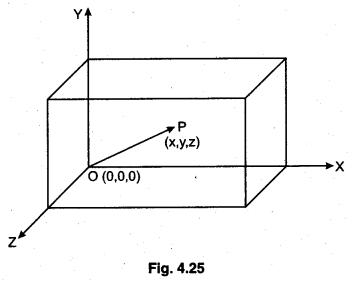
Inertial Frame of Reference
A frame of reference that remains at rest or moves with a constant velocity with respect to the other frame of reference is called ‘Inertial Frame of Reference’. An inertial frame of reference is actually an unaccelerated frame of reference. Newton’s law of motion are valid in all inertial frames of reference. In this frame of reference, a body is not acted upon by external forces. All inertial frames of reference are equivalent for the measurement of physical phenomena.
Examples :
1. Our Earth.
2. A space shuttle moving with a constant velocity relative to the earth.
3. A rocket moving with a constant velocity relative, to the Earth.
Non-inertial Frame of Reference
A frame of reference is said to be a non-inertial frame of reference when a body, not acted upon by an external force, is accelerated. In non-inertial frame of reference, Newton’s law of motion are not valid unless we introduce a force, called pseudo force.
For example : A freely falling elevator may be taken as a non-inertial frame.
Is Earth an Inertial-Frame of Reference?
The Earth rotates around its axis and also revolves around the Sun. In both these motions, centripetal acceleration is present. Therefore, strictly speaking the Earth or any frame of reference fixed on Earth can not be taken as an inertial frame. However, as we are dealing with speed ≈× 108m/s, (speed of light) and speed of Earth is only about 3 × 104 m/s, therefore when small time intervals are involved, effect of rotation and revolution of Earth can be ignored. Further more, this speed of the Earth can be assumed to be constant. Hence, the Earth or any other frame of reference set up on the Earth can be taken as approximately inertial frame of reference.
On the contrary, a frame of reference which is accelerated is non-inertial frame.
Other examples of inertial frames of reference are :
- A frame of reference remaining fixed w.r.t. Stars.
- A spaceship moving in outer space, without spinning and with its engine cut off.
RBSE Class 11 Physics Chapter 4 Numerical Questions
Question 1.
Determine the maximum acceleration of the train in which a box lying on its floor will remain stationary. It is given that the coefficient of static friction between the box and the floor of the train is 0.13. (g = 9.8m/s2)
Solution:
Given ; μs = 0.13; g = 9.8m/s2; amax =?
The frictional force acting between the floor of the train and the surface of the box, will oppose the slipping of the box on the floor of the train.
∴ Limiting friction force
fs = mamax
and fs = μsN = μsmg
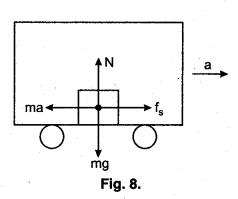
∴ m.amax = μsmg
or amax = μsg = 0.13 × 9.8
or amax = 1.274 ms-2
or amax = L27 ms-2
Question 2.
A cyclist speeding at 18 km/h on a level road takes a sharp circular turn of radius 3 m without reducing the speed. The coefficient of static friction between the tyres and the road is 0. 1. Will the cyclist slip while taking the turn?
Solution:
Given; v = 18km/h = 18 × \(\frac{5}{18}\) = 5 m/s,
r = 3m
μs = 0.1; g = 9.8 m/s2
The limiting friction available to cyclist,
fs = μsN = μsmg
Required centripetal force,
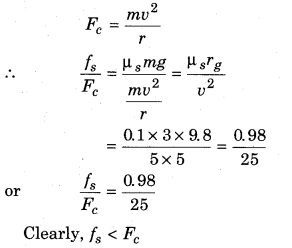
Therefore, cyclist will slip on the turn and fall down.
Question 3.
A bomb at rest explodes into three fragments. Two fragments fly off at right angles to each other. These two fragments: the one with mass 2 kg moves with a speed of 12 m/s, and the other one with mass 1 kg moves with 8 m/s. The speed of the third fragment is 20 m/s, then calculate its mass.
Solution:
Given; m1 = 2 kg; v1 = 12 m/s; m2 = 1kg;
v2 = 8 m/s; m3 = ?; v3 = 20 m/s
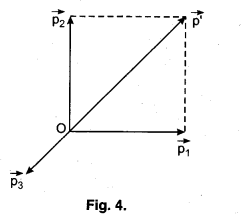
The momentum of all the three fragments,
P1 = m1v1 = 2 × 12 = 24 kg m/s
p2 = m2v2 = 1 × 8 = 8 kg m/s
p3 = m3v3 = m3 × 20
or p3 = 20 m3 kg m/s
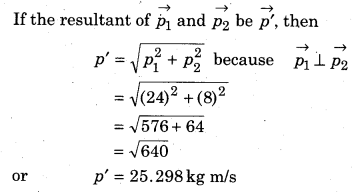
According, to the conversation of linear momentum,
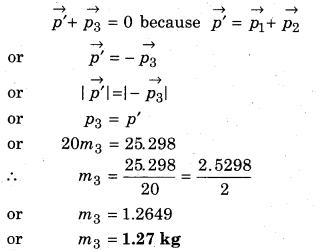
Question 4.
Two masses 8 kg and 12 kg are connected at the two ends of a light inextensible string that goes over a frictionless pulley. Find out the acceleration of the masses and the tension in the string when the masses are released.
Solution:
Given; m1 = 12 kg; m2 = 8kg
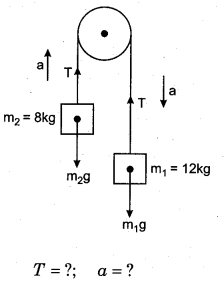
When the masses are released, mass being heavier will move downwards and m2 will move upwards with the same acceleration.
Now equation of motion for mass m1,
m1g – T = m1a ……………. (1)
and that for m2,
T – m2g = m2a …………….. (2)
On adding equation (1) & (2), we get
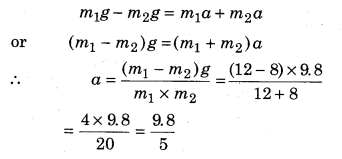
or a = 1.96 m/s 2
≈ 2m/s2
From equation (2),
T2 = m2g + m2a
= m2 (g + a)
= 8 (10 + 2)
= 8 × 12
= 96N
Question 5.
A batsman deflects a ball by an angle of 45° without changing its initial speed which is equal to 54 km/h. What is the impulse imparted to the ball when the mass of the ball is 0.15 kg?
Solution:
Given; v = 54 km/h
or v = 54 × \(\frac{5}{18}\) = 15 m/s
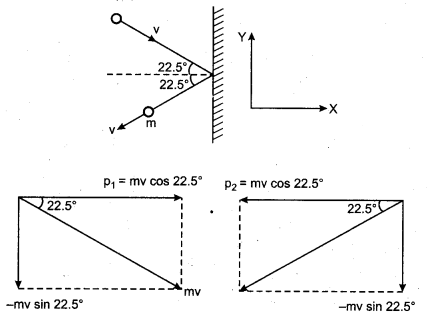
As is clear from the adjoining diagram, that there is no change in momentum in Y-direction,
Therefore, Δpy = 0
∴ Iy = 0
Change in momentum in X-direction
Δpx = p2 – p1 = -mv cos 22.5° – mv cos 22.5°
or Δpx = -2 mv cos 22.5°
∴ Impulse, Ix = Δpx
(From – Impulse-momentum theorem).
or Ix = -2mv cos 22.5°
= -2 × 0.15 × 15 × 0.9239
= -4.15755
= – 4.2 N.s.
Total impulse,
I = Ix + Iy
= -4.2 + 0 = – 4.2 N.s.
or I = – 4.2 N.s.
Here, the negative sign indicates that this impulse is acting in -X direction.
∴ Magnitude of impulse I = 4.2 N.s.
Question 6.
A constant retarding force of 50 N is applied to a body of mass 20 kg moving initially with a speed of 15 m/s. How long does the body takes to stop?
Solution:
Given; u = 15m/s; v = 0; t = ?
F = 50N, m = 20kg
∴ Retardation,
a = \(\frac{F}{m}=\frac{50}{m}=\frac{50}{20}\) = 2.5 ms-2
Now applying the equation, v = u + at
0 = 15 – 2.5t ⇒ 2.5t = 15
∴ t = \(\frac{15}{2.5}\) = 6 sec
or t = 6 sec
Question 7.
A shell of mass 0.020 kg is fired by a gun of mass 100 kg. If the muzzle speed of the shell is 80 m/s, then what is the recoil speed of the gun?
Solution:
Given; Mass of the gun M = 100kg; mass of shell m = 0.02 kg; speed of the shell v = 80 m/ s; speed of the gun v = ?
Applying the law of conservation of momentum,
Total momentum after fire = Total momentum before fire
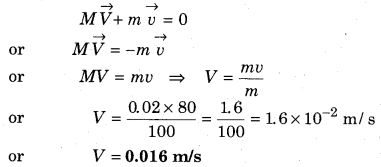
Question 8.
The motion of a particle of mass 0.1 kg is described by y = \(0.3 t+\frac{9.8}{2} t^{2}\). Find out the force acting on the particle.
Solution:
Given; m = 0.1kg; y = \(0.3 t+\frac{9.8}{2} t^{2}\); F = ?
∴ Velocity v = \(\frac{d y}{d t}=\frac{d}{d t}\left(0.3 t+\frac{9.8}{2} \cdot t^{2}\right)\)
or v = 0.3 + \(\frac{9.8}{2}\) × 2t
or v = 0.3 + 9.8t
Now, the acceleration,
a = \(\frac{d v}{d t}=\frac{d}{d t}(0.3+9.8 t)\) = 0 + 9.8
or a = 9.8 m/ s2
Therefore, the force acting on the particle,
F = ma = 0.1 × 9.8
or F = 0.98 N
Question 9.
A stone of mass 0.25 kg tied to the end of a string is whirled round in a circle of radius 1.5 m with a speed of 40 rev/min in a horizontal plane. What is the tension in the string? What is the maximum speed with which the stone can be whirled around if the string can withstand a maximum tension of 200 N?
Solution:
Given; m = 0.25kg; r= 1.5 m; Tmax = 200N;
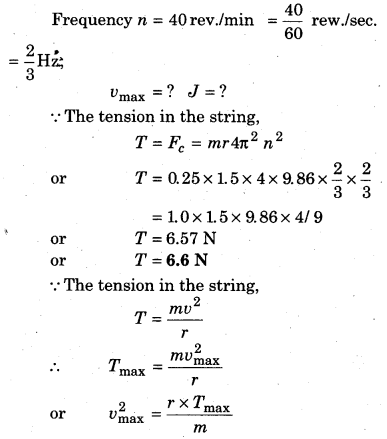

Question 10.
A body of mass 5 kg is acted upon by two perpendicular forces 8N and 6N. Give the magnitude and direction of acceleration of the body.
Solution:
Given; m = 5 kg; F1 = 8N; F2 = 6N;
a = ?; θ = 90°
